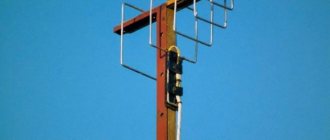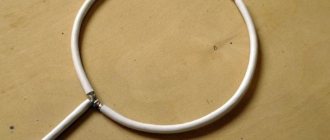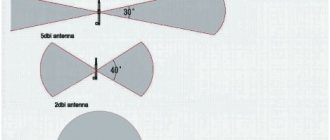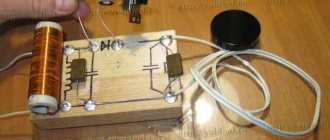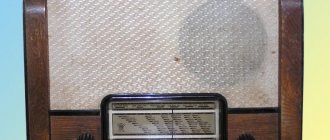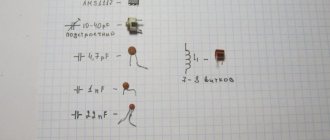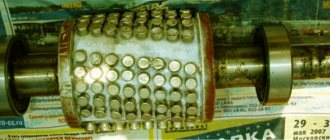Connecting to the mobile Internet of cellular operators Beeline, MTS, Tele-2 and others does not always give good results. The quality of the received signal depends on what coverage area of a given operator the receiving device is located. To strengthen a weak signal, you need an external antenna for the 3g modem. Its installation will increase not only the signal level, but also the Internet speed.
AX-2014Y external 3G antenna
Antenna types
3G modems already have an internal antenna, which allows you to work with an external signal without additional amplification. The internal location of the receiving device ensures stable operation of the modem only in the area of reliable reception. If the signal is weak or inconsistent, then an external outdoor antenna is needed. Based on this, we can divide by type into the following designs:
- internal;
- external (street).
A 3G modem connected via a USB input to the PC system unit cannot always provide high-quality Internet operation. To do this, it is necessary to strengthen the signal by adding an external structure.
Own antenna inside the modem
External antennas for modems are located outside. They are mounted on the walls of buildings, on masts, and placed on the roof. The higher the 2g and 3g antennas are, the more confidence in their high-quality performance. When installing, it is advisable to fulfill the following conditions:
- strength of the supporting base and fastenings;
- protection from external factors;
- avoidance of long horizontal sections and twisting into rings during cable descent;
- reliability of contact at the points where the cable is connected to the antenna.
This is because if the antenna is dropped, it may be damaged or cause harm to others. Frequently lowering and raising an antenna or climbing a person onto the roof to repair damage is a troublesome task.
Important! Not only altitude and terrain orientation affect the performance of a signal catcher. It is necessary to pay attention to the different types of antenna designs.
Making an antenna from a tin can
The advantage of this homemade antenna is its convenience. In every home you can find a free can, be it coffee or soda. It is better if it is cylindrical - without corners. The bank will be a kind of “hearing aid” for the waves. They will reach the bottom and bounce off it. As a result, a standing wave is formed in the bank.
What you need to do with the can to make an antenna out of it:
- Let's consider the simplest option - without using threads. All you need is a bank and a modem. Remove the lid from the jar. We make a hole in the wall closest to the bottom for the modem.
- We insert the modem into the hole so that the back with the built-in antenna is in the can.
- We take a USB extension cable and connect the modem to the computer through it. We place the modem in a jar on the windowsill or closer to the window. We monitor the number of divisions and adjust the position of the can using a modem so that the signal is maximum.
Insert the modem into the hole
The disadvantage of this method is that it is not suitable for all cases, for example, if you live on the first or second floor and your house is far from the tower. This may help you if the signal problems are not too severe. Therefore, the antenna is easy to manufacture, but not as effective as, for example, the Kharchenko antenna.
A more complex version of a stationary antenna - with a metal connector inside and a wire coming from it:
- It is necessary to drill a hole in the container for the connector. It is best to use a connector with a nut.
- You need to solder the pin of a piece of copper wire to the connector; the connector is screwed into the can (you need to make sure that it has electrical contact with the inside of the can, as it is sometimes painted).
- After this, all that remains is to make a cable to connect the antenna to the modem.
The antenna can be made with a cable
Varieties
DIY 4G antenna for modem
Such devices differ not only in price and size, but also in appearance. There are several of them:
- wave channel;
- panel;
- pin;
- parabolic.
The most suitable antenna for small built-up areas is the “wave channel” type antenna. It is known as the Yagi antenna. Structurally, the model is made in the form of vibrators (half-wave dipoles) located parallel to each other, located on the radiation line in the same plane. It consists of an active and many passive vibrators. This is a device from the class of traveling wave catchers. This design was invented and implemented by two Japanese, Yagi and Uda, back in 1926.
A directional antenna changes its characteristics if:
- length of dipoles;
- diameter of dipoles;
- the distance between them and the active vibrator;
- the presence of a passive element (reflector) behind the active vibrator;
- the number of passive elements (directors) in front of the active vibrator.
Factory-made models are known, such as BS-2000-17, BS-2000-20. Similar samples have already undergone numerous field tests. Narrow-frequency directivity helps to receive three G-signals at a frequency of 2100 MHz at k gain = 17-20 dBi. In addition, the overall dimensions L = 1000 mm and weight 0.5 kg make it possible to easily place the antenna signal catcher at a sufficient height, placing it on the mast.
Yagi-Uda device
The next type to be considered is pin type. This is a quarter-wave dipole, made in the form of a vertically located rod (pin). The device is designed to operate in the “receive-transmit” mode. The advantages include the fact that during installation the antenna does not require directional adjustment. It receives signals from all directions except vertical. The disadvantage is the lower gain.
For an approximate sample, the KORVET model is suitable. This is a 3G/4G signal catcher that allows you to work with mobile operators throughout the Russian Federation in the frequency range 700-2700 MHz. Thanks to the circular reception, the device works with cellular communication standards: GSM-900, GSM-1800, UMTS-2100 and LTE2600, etc.
This type of device is used on mobile devices: cars, boats and the like: where the signal is stable. The circular radiation pattern allows you to change the location of the receiver relative to the transmitter without affecting operation. The pin, protected by a plastic casing, can also be installed on stationary objects. It can receive reception from several base stations from different directions. When working in “transfer” mode, it is possible to distribute a WiFi signal.
GSM KORVET omnidirectional whip antenna
It is advisable to use the parabolic design of devices for receiving a 3G signal at a distance from the tower of more than 10 km.
Attention! Parabolic antennas require prior determination of the direction of the signal. The quality of work depends on the correct installation and accuracy of settings. When installing such a structure, it is advisable to involve a specialist.
Signal search
So, you are out of town and want to provide yourself with communications. Climb to the roof, attic, or highest point near the house or location you want. If your phone can catch the network, but at the limit (or unstable), you have every chance to improve the situation by using an external antenna. If the distance to the station is less than 30 km, and the network is not available, also try using an antenna. In the latter case, try to negotiate with the sellers to return the antenna if the experiment fails.
If the signal, although very weak, was still caught, dial any city number to check. If during a conversation, audibility is normal and the interlocutor does not complain about the loss of parts of your speech, then the energy of both lines (UL and DL) is balanced and you can use a standard antenna tuned to the middle frequency between the receiving and transmitting frequencies. If the interlocutor disappears from time to time, it is necessary to “strengthen” the downward direction from the base station to your phone. It might be worth looking for a phone with better sensitivity. But if it is difficult to hear you, you should strengthen the direction from your phone to the base station. Already at this stage it is clear that when choosing the type of antenna and its parameters, it is advisable to take into account the operator’s data and reception conditions.
In areas of poor reception, interference (noise) is often observed between channels with the same and adjacent frequencies. Unfortunately, the frequency resource allocated to GSM 900 operators in Russia is limited, which is why frequencies from different base stations with the same or neighboring signal strengths are often “visible” in areas of poor reception. Such frequencies create mutual interference that interferes with communication, and at certain signal levels communication becomes completely impossible. If a strong signal from the base station is recorded on the phone screen, but it is not possible to establish a connection, or if it is possible, but speech disappears all the time, then you are faced with “strangers”. It is not always possible to “force” a phone to select a different frequency, but a special function of Nokia phones - Netmonitor - allows you to do this.
I encountered a similar problem at my dacha, which is separated from a large city by a fairly open space. The phone received adjacent frequency channels with levels of 70 dB, 73 dB and 72 dB, but the quality of communication left much to be desired. The only thing that saved me was the forced selection of another frequency channel with a lower level - 80 dB. However, with a limited frequency resource, even frequency rescheduling of the network does not always help. However, if your phone does not have Netmonitor, you can use an external directional antenna with a good radiation pattern. All that remains is to make the right choice.
Panel antenna
Antenna for Yota - for modem and internet center
Panel construction is more advanced and higher in price. Its design allows the use of models of this type both in open space and in landscapes with loose buildings.
For example, a 2g antenna of the GSM 3G Nitsa-2 brand is a panel version. It allows you to improve the quality of the Internet signal for mobile modems, even where the signal is almost completely absent. The device works with standards: 2G, 3G, 4G. With a gain of 11 dBi, it is equipped with an N-type connector for connecting the lead cable.
Structurally, it consists of a set of some segments (metal plates) located at a certain distance from the flat reflector, and an amplifier circuit.
Panel antenna 2G GSM 3G Nitsa-2
frequency range
The instructions for each cell phone, as well as a modem for the mobile Internet, indicate the frequencies at which cellular operators broadcast their signals.
Antenna for modem
Recommendation. The shape and size, respectively, and the characteristics of the purchased or manufactured antenna depend on the frequency of the received signal.
Broadband devices can be classified as a universal type; their performance will be mediocre. If you know the exact broadcast frequencies of the operator in the region and select an antenna specifically for these frequencies, the result will be an order of magnitude higher.
Standards of some Russian cellular operators (frequencies in MHz):
- UMTS: UL/DL – 1920-1980 (880 – 915)/2110 – 2170 (925 – 960);
- CDMA: UL/DL – 453 – 457.5/463 – 657.5;
- 4G: UL/DL – 2500 – 2570/2620 – 2690.
Clarification. First you need to make sure what standards the USB modem you are purchasing will work with. Next, clarify that it has a place to connect an external antenna. Then find out what frequencies this standard works with and select an antenna.
Description of a homemade receiver
A homemade passive panel-type antenna to increase the signal for a 3G modem will serve both as a signal receiver and as an amplifier. For handmade production, the design developed by V. Kharchenko is best suited. This is the so-called “biquadrat”, which has a slightly curved reflector behind it. The arrangement of the components in the same plane allows the assembled parts to be installed in a sealed housing.
Biquadrat Kharchenko
Device and optimal dimensions
The width of the received range and the signal amplification factor increase along with the increase in design dimensions. When building a device, a compromise must be sought. For a detailed description of manufacturing as a 2g and 3g antenna, you can focus on the Kharchenko biquadrat. This small-sized option can be located both indoors and outdoors. It performed well as a signal receiver for mobile Internet.
There is a template for selecting the size of a Kharchenko biquadrat depending on frequency: online selection, programs that can be found on the Internet.
Basic requirements for a vibrator
The vibrator body is made of aluminum or copper of circular cross-section. It could be a tube, it could be a solid rod. A cross-section of the vibrator body of 5-7 mm2 is considered suitable. Based on the formula for the cross-sectional area of a circle S = 2πR = πD, the diameter can be easily determined by dividing the required cross-sectional area by the number π = 3.14. Then use a caliper to measure the workpieces of suitable length. Suitable diameter is 2.5-3.5 mm. The side of the quadrilateral must correspond to the wavelength.
Attention! As practice has shown, it is easier to work with copper or brass blanks because they can be soldered. Since for our purposes we need good contacts, it is best to solder all connections. It is also better to connect the cable to the finished structure using soldering.
If there are no copper tubes or rods at hand, then the aluminum “whiskers” of the meter range of the Polish “grid” antenna are perfect for this purpose. Their length will be enough to make a vibrator. You need to bend the workpiece so that the ends of the segment meet in the center. The ends can be flattened, holes drilled into them and the cable attached using bolts and nuts.
Polish antenna type "lattice"
Cable selection
To minimize signal loss, it is advisable to select a cable with lower resistance. It should lie in the range from 50 to 55 Ohms. The wire looks thinner than a regular television wire, so it fits perfectly with the mechanical dimensions of the vibrator. The wire must end with type F female-CRC9 connectors and adapters.
Specifics of the reflector design
This kind of screen can have a solid surface made of metal foil or a lattice surface. Main requirements:
- the size should be such that the edges protrude beyond the dimensions of the antenna;
- a distance of at least 36 mm must be maintained between the reflector and the vibrator;
- the reflector is slightly bent, placing the distant point opposite the center of the antenna.
The material for creating a reflector can be very different, but it must be made of metal.
DIY antenna for 3G modem
Homemade 4G antenna at home - Kharchenko, MiMO and disk
You can make your own antenna to boost a 3G signal using a basic set of tools. For this you will need:
- copper TV cable at least 35 cm long;
- coaxial cable (2-3 m);
- bottle cap, tin can or foil;
- scissors to cut the cable;
- any glue.
You also need to prepare a ruler and marker for marking, pliers and a soldering iron to attach cables to the contacts. If you don’t have glue on hand, you can make it yourself from polystyrene foam and gasoline (or acetone) by connecting the components at the bottom of a glass container.
How to make an antenna for a 3G modem? To do this, you should take into account some subtleties.
Device creation process
How to make an antenna can be seen in the figure below. If all dimensions are met, the 3g antenna will start working immediately. The step-by-step production itself consists of the following points:
- Calculate the size of the perimeter of the square. To do this, they turn to the wavelength, which is found from the desired signal frequency λ = 300000/f, here λ is the wavelength (mm), f is the frequency (MHz). So, for a frequency of 2100 MHz (4G modem) λ = 143 mm. In each case, the sizes are individual.
- Bend squares from a copper rod with a diameter of 2...5 mm with a side equal to 1/4 of the perimeter. Therefore, the length of each side is 36 mm. When bending, observe the angles and position of the sides in the same plane.
- A coaxial wire with a resistance of 50 Ohms is soldered to the ends of the antenna, having previously tinned the soldering points. The central core is soldered to one connection point, the screen to another. The second end of the cable ends with a connector suitable for connecting to a USB modem.
- The manufacture of a reflector depends on the material from which it will be made. The dimensions of the screen should exceed the dimensions of the vibrator by 2-2.5 cm. A hole is made in the center for an insulating sleeve (stand) to which the vibrator will be attached. The center of the rectangle is simply located at the intersection of the diagonals.
- The size of the stand can be selected immediately or made adjustable to select the distance. After the final setting of the distance, the stand is fixed.
For your information. In case of outdoor installation, the finished structure can be placed in a suitable plastic case. Placement inside the housing is carried out on insulating bushings; a hole is drilled in the housing for supplying the antenna wire.
Main dimensions of the device
Connection and signal transmission options
It is best to make connections using connectors that match the size of the cable and the input connector of the modem. The signal is supplied from the antenna to the modem via an antenna wire long enough to connect it to the antenna. The installed signal catcher must be directed towards the location of the cellular operator tower.
Carefully. Avoid laying the cable in common channels with AC wires, as well as close proximity to heating appliances. When placing the device outdoors, it is advisable to protect the cable from mechanical damage.
Send data wirelessly
It happens that it is not possible to stretch the wire through the living space. Or the apartment is located on the upper floors of a high-rise building, and there is no balcony. In this case, it is problematic not only to fix the antenna outside, but also to lay the wire through the entire home.
In order not to connect the antenna to the modem using a cable, you can turn it into a receiver-emitter. Instead of a cable, two electrodes are connected to the active points of the antenna. Their length is equal to the length of the modem circuit. By measuring the length of the outer outline of the modem with a thread and adding 7 mm to it, you get the length of the electrode. Its width ranges from 45 to 50 mm. The electrodes are bent along the following trajectory:
- one electrode - in the form of a semicircle;
- the other electrode is based on the modem configuration.
The soldered electrodes are slightly spread apart. Thus, the Kharchenko biquadrat receives a wireless Internet signal and emits a significant part of it, which will be caught by the modem’s built-in antenna. Within an apartment or room, this will be quite enough for stable operation of the Internet using such a homemade Wi-Fi.
A 3g antenna, no matter whether it is bought in a store or made by yourself, will strengthen the signal. Mobile Internet from a cellular operator will become more stable and faster. A self-made design will bring pleasure from the result and save the family budget.
What materials will be needed?
There is no need to buy any additional equipment. The necessary parts to create an antenna are in the workshop.
For this you will need:
- Wire, any wire except copper wire. Recommended length: 30-40 cm.
- Connecting block and fastening elements.
- Polymer pipe (up to 20 cm long).
- Cable.
A homemade antenna must be fixed during the manufacturing process, so it’s worth stocking up on electrical tape.
The issue of cable selection plays an important role. Domestic coaxial cable has a limited scope of application. It is better to choose imported analogues with double braid; they can be easily found in construction supermarkets. However, some antennas are already sold with a coaxial cable included. For example, pin models.
Antenna equipment.
Most models have a special connector for connecting to a phone. Some devices even have antenna leads. These are short pieces of cable equipped with appropriate connectors. Even if they are not included in the package, if necessary, parts can be purchased separately.
